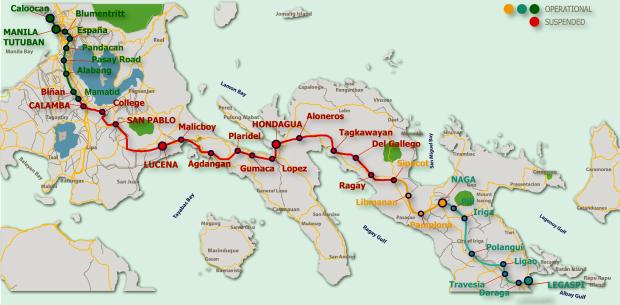P175-B development aid from China to revive PNR’s Bicol Express

PNR Southern Luzon route (Image from the website of the Philippine National Railways)
NAGA CITY — Using the P175-billion overseas development aid to be borrowed from China, the Department of Transportation (DOTr) will revive the operation of the Philippine National Railway’s Bicol Express with reconstruction of a new railway system from Manila to Bicol, Undersecretary for Rails Cesar Chavez said.
“It is not a rehabilitation,” Chavez said at the Bicol Express Modernization Forum held here on Friday. “It will be a reconstruction. Everything will be new. New railways. New train wagons. New stations. New modalities.”
Chavez said China and the Philippines is set to sign the loan agreement of P175 billion payable in 20 years at 2 percent interest per annum on Nov. 16 and 17 at the time of the 31st Asean Summit and Related Meeting in Manila.
He said the revived Bicol Express would take six hours to reach Bicol from Manila with a design speed of 120 kph and operational speed of 80 kph.
With a timetable from 2018-2022, he said the reconstruction of the new railway system would be undertaken through Chinese general consultancy services while the determination of the firms to undertake the actual construction was still under negotiations.
Article continues after this advertisementHe said there would be nine new train stations from Paco in Manila to Matnog town in Sorsogon, stretching 683 km of newly constructed railways following international standards.
Article continues after this advertisementHe enumerated the nine train stations to be constructed as Paco, FTI, Los Baños, Lucena City, Gumaca, Pili/Naga, Legazpi/Camalig, Sorsogon City and Matnog.
Chavez said China wpi;d bring in and transfer technology and operational expertise to Filipino engineers and operators while utilizing Chinese consultants and contractors. Filipino engineers would handle the maintenance and operation, he said.
Chavez said the Chinese government has agreed to start the reconstruction of the new railway system for the PNR’s Bicol Express after the national government had done with the right-of-way aspect of the trunk line from Manila to Sorsogon.
The third quarter of 2018 is the target period to complete 50 percent of the right-of-way aspect involving payment and relocation of settlers occupying spaces within the 15 meters trunk line from Manila to Matnog.
Demolitions and relocations
Depending on the situation, Chavez said, the reconstruction of the railway system might utilize the same alignment of the previous railway system of the PNR. But whenever practical and necessary, a new alignment for the railways would be established.
He warned occupants within the 15 meters of te right-of-way of the PNR that, after due process, the DOTr would implement demolition of structures.
From Manila to Malolos in Bulacan alone, some 443 structures are for demolition, he added.
Chavez said that from Paco to Matnog about 100,000 families would be affected by the reconstruction of the PNR railways of the Bicol Express of which 60,000 families have to be relocated from Pagbilao, Quezon to Legazpi City in Albay province.
He said they had outlined two strategies to hasten the relocation of families living around the railways, which include the mobilization of the local government units or the national line agencies.
Chavez said P45 billion of the project cost would be spent for the resettlement of affected families living within the trunk line while some P9 billion would be spent for land acquisition for the new alignment of the railways.
He said the civil works would cost P102.72 billion; station development and depot, P1.4 billion; electrical and mechanical system, P4.08 billion; rolling stock (trains), P11.60 billion; machinery and equipment, P1.37 billion; and pre-operating expenses, P400 million.
Wait and see
Though elated by the news of the revival of the Bicol Express with the reconstruction of the railways going to Bicol, businessman Aping Olivan would only believe the good news once it had become operational.
“There are so much opportunities for business and trade, but we must first wait and see,” Olivan said. “Presidents have come and gone and the talks about the revival of the train operation is always raised by not achieved.”
Vic Nierva, an environmental activist and instructor at the Ateneo de Naga University, expressed doubt about what Chavez had presented to the forum.
“I have mixed feelings and reactions towards what took place at the Bicol Express Modernization Forum,” Nierva said in a post on his Facebook page. “Honestly, aside from the picture of a perspective of a DMU, nothing was new in the presentation of DoTr Usec. Chavez.”
He added: “Year after year since the time of Pres. Ramos, we have been presented with the same plans. We have been loaning billions from other countries. We have been rehabilitating the railroad. Yet, we continue to experience the same problems in our railway system.”
He said there were no evaluations or assessment about whatever happened to previous rehabilitation projects. /atm